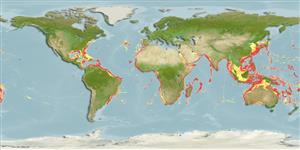Environment: milieu / climate zone / depth range / distribution range
Écologie
marin benthopélagique; profondeur 9 - 1210 m (Ref. 9872), usually 200 - 500 m (Ref. 3583). Subtropical; 43°N - 35°S
Eastern Atlantic: Madeira and the Canary Islands to Senegal, Gulf of Guinea and South Africa. Western Atlantic: southern Scotian Shelf, Canada to Greater Antilles, western Caribbean, Panama and northern Gulf of Mexico (Ref. 7334). Indo-Pacific: off Natal (South Africa), Bay of Bengal, southern Australia, Chatham Plateau around New Zealand, and the Philippines (Ref. 4181). Also in northern South America (Moore, pers. comm.).
Taille / Poids / Âge
Maturity: Lm ? range ? - ? cm
Max length : 60.0 cm TL mâle / non sexé; (Ref. 3695); common length : 45.0 cm TL mâle / non sexé; (Ref. 3695)
Épines dorsales (Total): 7 - 8; Rayons mous dorsaux (Total): 13-14; Épines anales 3; Rayons mous anaux: 11 - 12. Head with a concave forehead profile and with large mucous cavities covered by tough skin; mouth large and oblique; opercle and preopercle each with a large strong spine; body deep, about 2.1 times in SL; ventral keel with 10 - 14 very robust scutes; caudal fin forked but rounded. Color of head and body is dusky pink, sides with silvery tinge, fins red; tongue and gill cavity blackish; palate white to red (Ref. 7331). Pale beet red to light rosy. Back light red to brownish red, lower sides light silvery gray (Ref. 37108).
Lives close to or on the bottom of the upper continental slope. Prefers hard substrates. Young specimens feed on small shrimps and fish (Ref. 4784). A deep sea species, nonetheless, the young are often found near the coast (Ref. 9137). Utilized as fishmeal and source of oil in eastern central Atlantic (Ref. 3695).
Life cycle and mating behavior
Maturité | Reproduction | Frai | Œufs | Fécondité | Larves
Maul, G.E., 1990. Trachichthyidae. p. 620-622. In J.C. Quéro, J.C. Hureau, C. Karrer, A. Post and L. Saldanha (eds.) Check-list of the fishes of the eastern tropical Atlantic (CLOFETA). JNICT, Lisbon; SEI, Paris; and UNESCO, Paris. Vol. 2. (Ref. 3583)
Statut dans la liste rouge de l'IUCN (Ref. 130435)
Menace pour l'homme
Harmless
Utilisations par l'homme
Pêcheries: commercial
Plus d'informations
Noms communsSynonymesMétabolismePrédateursÉcotoxicologieReproductionMaturitéFraiRassemblement de ponteFéconditéŒufsDéveloppement de l'œuf
RéférencesAquacultureProfil d'aquacultureSouchesGénétiqueElectrophoresesHéritabilitéPathologiesTraitementNutrientsMass conversion
CollaborateursImagesStamps, Coins Misc.SonsCiguateraVitesseType de nageSurface branchialeOtolithesCerveauxVision
Outils
Articles particuliers
Télécharger en XML
Sources Internet
Estimates based on models
Preferred temperature (Ref.
123201): 8.1 - 18.7, mean 12.2 °C (based on 848 cells).
Phylogenetic diversity index (Ref.
82804): PD
50 = 0.7500 [Uniqueness, from 0.5 = low to 2.0 = high].
Bayesian length-weight: a=0.01549 (0.00901 - 0.02662), b=3.07 (2.92 - 3.22), in cm total length, based on LWR estimates for this species & (Sub)family-body (Ref.
93245).
Niveau trophique (Ref.
69278): 3.9 ±0.65 se; based on food items.
Résilience (Ref.
120179): Très faible, temps minimum de doublement de population supérieur à 14 ans (Preliminary K or Fecundity.).
Fishing Vulnerability (Ref.
59153): Moderate vulnerability (44 of 100).
Nutrients (Ref.
124155): Calcium = 24.4 [10.0, 119.6] mg/100g; Iron = 0.646 [0.308, 1.494] mg/100g; Protein = 16.9 [15.5, 18.4] %; Omega3 = 0.319 [0.117, 0.902] g/100g; Selenium = 54.7 [19.5, 151.2] μg/100g; VitaminA = 24.7 [4.9, 138.9] μg/100g; Zinc = 0.632 [0.395, 1.045] mg/100g (wet weight);
